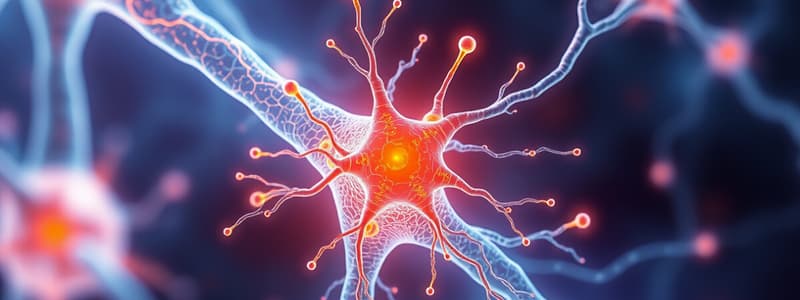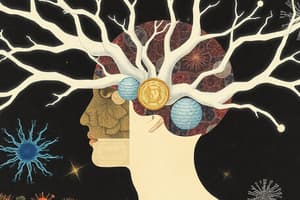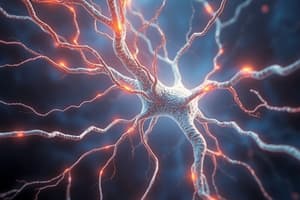Podcast
Questions and Answers
What role does the axon hillock play in a neuron?
What role does the axon hillock play in a neuron?
- It provides insulation for the nerve fiber.
- It receives signals from other neurons.
- It connects the neuron to other cells.
- It integrates incoming signals and initiates action potentials. (correct)
Neurons do not have nuclei like other cells in the body.
Neurons do not have nuclei like other cells in the body.
False (B)
What are the two types of signals that can arrive at the axon hillock?
What are the two types of signals that can arrive at the axon hillock?
excitatory and inhibitory
The fatty membrane that insulates most mammalian nerve fibers is called ______.
The fatty membrane that insulates most mammalian nerve fibers is called ______.
Match each part of the neuron with its function:
Match each part of the neuron with its function:
What happens at the axon hillock when excitatory signals reach a certain threshold?
What happens at the axon hillock when excitatory signals reach a certain threshold?
Myelin sheath helps in the loss of electrical signals within a neuron.
Myelin sheath helps in the loss of electrical signals within a neuron.
The cell body of a neuron is also known as the ______.
The cell body of a neuron is also known as the ______.
What are the small breaks in the myelin sheath called?
What are the small breaks in the myelin sheath called?
Oligodendrocytes produce myelin in the peripheral nervous system.
Oligodendrocytes produce myelin in the peripheral nervous system.
What are the cells that support and myelinate neurons called?
What are the cells that support and myelinate neurons called?
The space between two neurons is known as the ______.
The space between two neurons is known as the ______.
Match the following glial cells with their primary function:
Match the following glial cells with their primary function:
Which of the following symptoms is commonly associated with multiple sclerosis (MS)?
Which of the following symptoms is commonly associated with multiple sclerosis (MS)?
Neurons are physically connected to each other.
Neurons are physically connected to each other.
What purpose do neurotransmitters serve in the nervous system?
What purpose do neurotransmitters serve in the nervous system?
Multiple sclerosis is a disorder that leads to the destruction of ______.
Multiple sclerosis is a disorder that leads to the destruction of ______.
What type of nerve carries both sensory and motor information?
What type of nerve carries both sensory and motor information?
Study Notes
Neuron Structure and Function
- Neurons transmit electrical impulses and convert them into chemical signals.
- Neuron shape adapts to its function and surrounding cells.
- Common components of neurons include:
- Nucleus located in the cell body (soma), housing genetic material.
- Dendrites extend from the soma, receive incoming signals.
- Axon hillock integrates signals and initiates action potentials if threshold is reached.
Axons and Myelin
- Axons are long extensions that transmit signals away from the soma to target structures (muscles, glands, or other neurons).
- Myelin, a fatty insulator produced by oligodendrocytes (CNS) and Schwann cells (PNS), prevents signal loss and speeds up conduction.
- Nodes of Ranvier are gaps in the myelin sheath crucial for rapid signal communication along the axon.
Neurotransmission
- Nerve terminals or synaptic boutons are located at the axon’s end, facilitating neurotransmitter release into the synaptic cleft.
- The synaptic cleft is the small space between neurons allowing neurotransmitter signaling to the postsynaptic neuron.
Demyelination and Multiple Sclerosis (MS)
- Demyelination occurs when the immune system attacks myelin, slowing impulse conduction.
- MS specifically targets myelin in the brain and spinal cord, leading to a variety of symptoms (weakness, balance issues, vision problems, incontinence).
Glial Cells in the Nervous System
- Glial cells (neuroglia) support and myelinate neurons.
- Major types of glial cells include:
- Astrocytes: Nourish neurons, form the blood-brain barrier.
- Ependymal Cells: Line brain ventricles and produce cerebrospinal fluid (CSF) for support and shock absorption.
- Microglia: Act as phagocytes, clearing waste and pathogens from the CNS.
- Oligodendrocytes and Schwann Cells: Produce myelin.
Nerves and Tracts
- In the peripheral nervous system (PNS), neurons bundle to form nerves that may be sensory, motor, or mixed.
- Ganglia contain cell bodies of the same neuron type.
- In the central nervous system (CNS), axons bundle to form tracts, which carry a single type of information, with grouped cell bodies forming nuclei.
Studying That Suits You
Use AI to generate personalized quizzes and flashcards to suit your learning preferences.
Description
This quiz covers the essential structure and function of neurons, the specialized cells responsible for transmitting electrical impulses in the nervous system. It explores how neurons communicate and the various types of neurons found in the body. Test your knowledge on the fascinating world of neurons!





